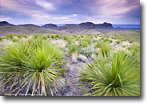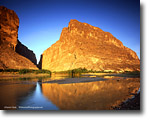|
Big Bend National Park in Texas is one of the five best National Parks, in my opinion. Yes, that is a bold statement. And yes, I stand by it. It may not be as well known as some others, but it offers up landscapes and scenery that few other places can match. It is certainly one of the best parks for a photographer and if you ever visit, you will certainly understand.
Big Bend’s natural features are many. It is the only US National Park to contain an entire mountain range within its borders. It also has more bird and reptile species than any other National Park and more than 175 species of butterflies. The Rio Grande forms the international border for over a hundred miles in the Park. The river flows through three magnificent canyons and is designated as a Wild and Scenic River, making it one of the premier float trips in North America. Any one of these would make it interesting on its own, but all of these together in one Park make it someplace very special.
The End Of The Road
How remote is Big Bend? You have to want to go there because it truly is the end of the road. It is also the United States-Mexico border. To go any further, you need a passport. There is neither TV nor radio service here. Cell towers arrived at the neighboring village of Terlingua recently, but the coverage is poor and all but non-existent in the Park. The newspaper delivered into the area is a three-day-old copy of the El Paso paper. The closest doctor is 100 miles away.
Even the visitation here is low. Yosemite, by contrast, sees more people in two weeks than Big Bend does all year. Yet as a National Park, you will find a simple rustic lodge, a couple of nice campgrounds, and just enough services (like a gas station) to make it comfortable.
Seasons
As a desert, one would expect it to be dry and hot. That is true, especially in the early summer. May through July is downright hot and visitation all but stops. Winters here are generally mild with the occasional cold snap (including snow). Spring arrives in February and the wildflowers and cactus put on a display into late April. Late summer brings the 5th season - a second spring. Tropical storms push moisture into the southwest creating the monsoon rains and a second spring complete with more wildflowers. The river is at its best then and the desert can be downright lush. This fades into a nice fall that lasts into late December.
The Landscape and Wildlife
The landscape here is spectacular and diverse. With elevations ranging from 1800 feet at the river to almost 8000 feet in the Chisos Mountains, there are several ecosystems that offer a variety of topography, scenery, and wildlife.
Lush riparian habitat thrives along the Rio Grande River. Desert flatlands of creosote and cactus stretch for many miles away from the river and mountains. Sotol grasslands grow in the foothills and mid level elevations. Overlooking all of this is the “sky island” alpine environment of the Chisos Mountains.
This is a harsh desert environment yet tall cottonwoods grow all along the river and at desert springs. The Chisos contain pines, maples and the southernmost aspens in the United States. There are also prime examples of cactus and the flora of the Chihuahuan Desert. What may seem empty, at first, is actually teeming with life.
For those interested in wildlife, there are birds galore. Some of the larger animals include coyotes, javelina, mountain lions, and black bear.
To add even more photographic possibilities, there are ranching and mining ruins for historical character and rock art to add a mysterious touch.
Visiting
The park is so big, I suggest several taking days while only trying to see part of it. I divide the park into four sections; the western side, Chisos core, north side, and eastern side. I believe the best and most photographic opportunities are in the western side and Chisos core and I tend to concentrate on those two sections.
The park has paved roads that take you to all the major sights. There is also a good rough road system that can get you further afield if you have a high clearance vehicle. The trail system varies from a short stroll to hardcore backpacking locations.
For the camper, I prefer the Cottonwood Campground on the western side of the Park. It’s a shady spot on the Rio Grande with well-spaced sites under their namesake cottonwood trees. There is water here and there are bathrooms too. There are no electrical hookups and generators are not permitted. The nearest gas is 40 miles away. Cottonwood is close to the interesting features on the western side of the park and is a good birding location. In the warmer months, you might consider the higher and cooler Chisos Basin Campground, but I find the sites too close together and too noisy, so I prefer the quiet remoteness of Cottonwood.
Those looking for more creature comforts, check the Chisos Mountain Lodge in the Basin. It provides rustic motel rooms similar to other NPS units. Otherwise, look in the village of Terlingua for basic motels.
For those with a high clearance vehicle and a sense of adventure, check out the back roads of Big Bend. The back roads form a network of unpaved rough roads that lead to many interesting out-of-the-way places and some roadside campsites. These campsites are nothing more than some flat gravel in the desert, but the drive, the view, and the solitude are magical.
Photography
The photography here is outstanding and great images can be made from the side of any road or as far into the back country you care to go. Unlike some other parks, you usually have a location to yourself too.
Here are just a few suggested locations to whet your appetite for what this park contains. Start to really explore it, and you will find there is a lifetime worth of things to see here.
Santa Elena Canyon One of the park's crown jewels and a must see. The Rio Grande carved the 1500' deep Santa Elena through the rock wall of the Sierra Ponce. You can stand at the front, look at the length of this huge vertical wall and watch the Rio Grande flow out of a narrow canyon. The wall faces east and gets great morning light. The canyon can be hiked into and floated as a river trip with permits. See the Park for the river permitting process as this is the international border and that means special requirements and reporting.
The Fiery Past The western side of the park had an active volcanic past and offers some great examples of plugs, dikes, cores, and tuff. See Fins of Fire, Mule Ears Peak, Tuff Canyon, and Cerro Castellan along the Ross Maxwell Scenic Drive for some great photography of interesting geology.
Scenic Viewpoints Sotol Vista (sunset), Desert Mountain Overlook (sunrise and sunset), and Mule Ears (sunset) offer easy roadside access to amazing views that are well worth the stop along the Ross Maxwell Scenic Drive.
Rugged dirt roads can get you to ruins and any number of out-of-the-way places. I particularly like Terlingua Abajo (sunrise). With a good 4x4 vehicle, take a day or two and drive the River Road as it follows the Rio Grande from Castolon to Hot Springs.
Trails in the Chisos lead to the Window (sunset), Lost Mine (sunrise), and South Rim. They vary from short hike to backpacking destinations.
Grapevine Hills This is an igneous uplift (near park head quarters) of large boulders that is home to the famous balanced rock (sunrise).
Mariscal Mine Located on the eastern side backroads, this is a fantastic cinnabar mining ruin to visit.
There is a lifetime worth of things to find here. Make one visit and I promise you will be back for more.
Comments on NPN nature photography articles? Send them to the editor. NPN members may also log in and leave their comments below.
Darren Huski is a landscape photographer from Fort Worth, Texas. He photographs the Lone Star State and throughout the American west and midwest. His work can be seen at www.WildernessPhotographer.net. Darren also blogs about his travels with a large format camera which can be followed at http://thetravelingcamera.blogspot.com.



